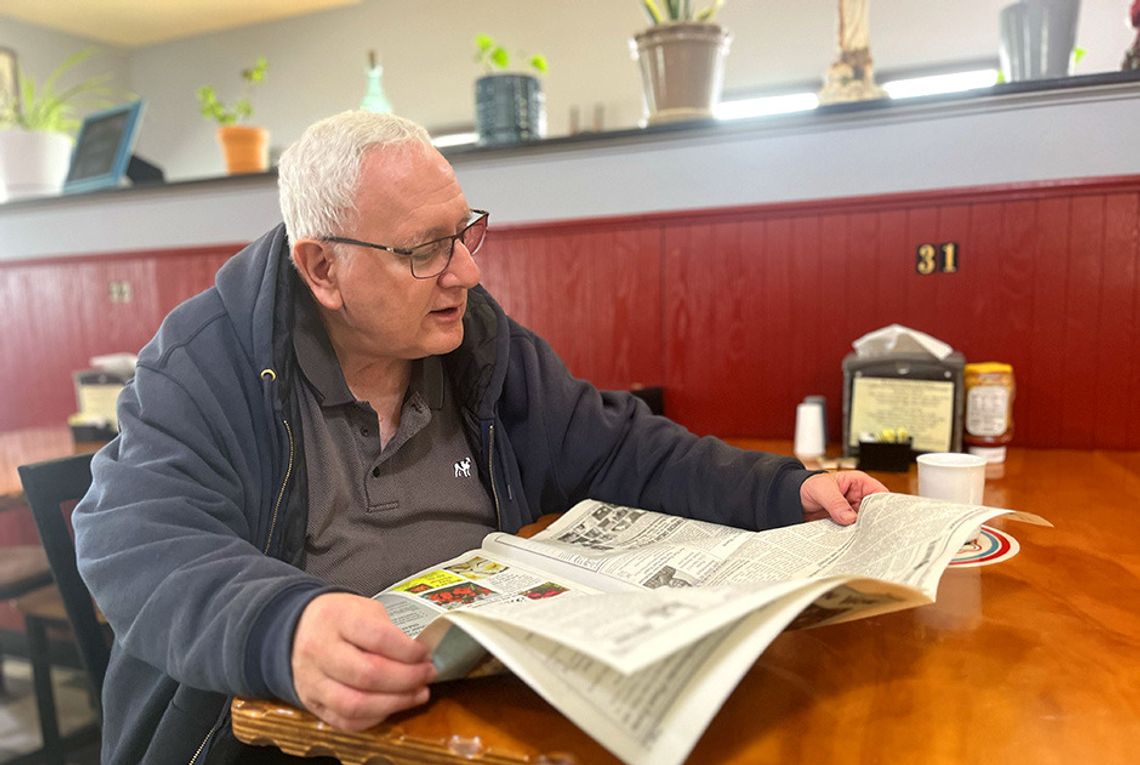by Ava Kian, MinnPost This story was originally published by MinnPost, https://www. minnpost.com/greaterminnesota/ 2024/05/ greater-rural-minnesotalocal- news-mahnomenpioneer- news-desert/ The Rev. John Cox opened the latest edition of the Mahnomen Pioneer as he sat and sipped his morning coffee at Pappy’s Cafe in Waubun, a village of 400 people in Mahnomen County in northwestern Minnesota.
A priest at St. Ann’s Church in Waubun, Cox said he reads the paper to catch up on what’s happening around him. “This is an important time because we’ve got a tribal election coming up and (the Pioneer) gives some good coverage of the candidates,” Cox said. “(The Pioneer is) absolutely important.”
For Robert Durant, the owner of a Mahnomen auto shop where people sit and read the paper while they wait for their cars to be fixed, the paper helps him to keep tabs on his city. “I get a good understanding of what Mahnomen is all about,” he said. “You know, because there’s a lot of great things that happen here. A lot of small towns, they’re disappearing.”
With a circulation of 1,200, the Pioneer is the only newspaper in Mahnomen County, meaning that, for many people like Cox and Durant, it’s the only source of information and connection with what’s going on in the area.
Indeed, the paper is deeply embedded into daily life in this county of 5,300 residents, which sits entirely within the White Earth Indian Reservation in this farflung part of the state.
Owner and editor Sue Kraft – who also reports, takes photographs, sells ads and performs many other duties for the publication — began working at the Pioneer in the 1990s. She bought the paper in 2010 and lives above her office.
She said the Detroit Lakes Tribune, located 35 miles to the south, doesn’t focus on Mahnomen. And the larger papers, like the Fargo Forum and the Minneapolis Star Tribune, will often cover big stories in town but not much else, she said.
So it’s up to the Pioneer.
Weeklies on the decline Across the nation, local news coverage has been on the decline for years — disrupted by the digital age and changing news consumption habits — and Minnesota is not the exception. In the past several years, the capacity of many news organizations has dwindled and many local papers have closed.
In April, Southwest News Media, which was acquired in 2020 by Denver-based MediaNews Group, shut down six weeklies in the Twin Cities suburbs. Two sister papers in rural areas, the Hutchinson Leader and the Litchfield Independent, also closed, along with MNG’s affiliate printing plant, Crow River Press.
Those papers covered niche politics and news across Chanhassen, Chaska, Jordan, Prior Lake, Shakopee and Savage.
Noah Mitchell, who was a reporter at the Chanhassen Villager (one of the papers that closed), said it was a critical piece for starting conversations and encouraging civic engagement. “The mayor mentioned the loss of the paper and how important community feedback is to the city government and how they’re going to be losing an outlet for that,” he said.
Studies have shown that civic engagement declines when local news outlets close. One review found that 81% of people who follow local news “very closely” are likely to vote, compared with only 35% of those who do not pay close attention to local news.
Some communities have found a way to survive.
Cher r yRoad Media, which owns papers in 17 states, started papers in Hutchinson and Litchfield just weeks after their papers were shuttered.
The company now has 12 papers in Minnesota. Chief executive Jeremy Gulban said it made sense for the company to pick up the two closed papers since it revived a paper in 2021 following the closure of a newspaper in International Falls on the Canadian border.
“When the announcement (of the closures) came out, our COO went out to Hutchinson in Litchfield and met with a bunch of folks there: the mayor, city managers, city council members, business people, chamber directors, etc., and really got a lot of positive feedback that the communities wanted to have a newspaper,” Gulban said.
The Hutchinson Station and Litchfield Rail were born.
Northwestern University’s Medill School of Journalism analyzed the presence of news outlets across the United States as a part of its annual “State of Local News” project. [Find the interactive map for detailed information about Minnesota]. It found that in 2023 local news outlets continued to close — at an even steeper rate than in previous years — and that the growth in new outlets and alternate local news has not kept pace with what’s being lost.
The researchers estimated that by the end of next year, the country will have lost a third of its newspapers since 2005. A majority of the communities affected by those closings have been poorer and without access to high-speed internet.
No companies, however, have come forward to resurrect the other six MediaNews Group papers, which were located in Carver and Scott Counties in the southwest metro region. The Patriot, with editions in Waconia and Norwood-Young America/ Watertown, soldiers on in western Carver County while in Scott County only the New Prague Times remains.
‘News deserts’ on the rise According to the study, people in more than half of the country’s 3,100 counties either do not have a local news outlet or have only a single surviving outlet. These counties are referred to as “news deserts” — communities where residents have limited access to critical news and information that nurtures both grassroots democracy and social cohesion. Minnesota has 15 counties with just one news source.
The study found that 1,562 counties have a single source of local news — generally a small weekly or daily newspaper that is either locally owned or part of a small chain and will cover everything from school board meetings to local government to high school sports.
Of those counties, researchers identified 228 as being at a heightened risk of losing their last remaining newspaper.
Mahnomen County is one of them.
The watch list was determined using the demographic characteristics of current news deserts – and seeing which counties already have limited news access and characteristics similar to news deserts, said Zachary Metzger, the director of the State of Local News Project. Poverty is one of those factors. Residents in the watchlist counties tend to be much poorer than those in the other counties that just have one news source.
.jpg)










